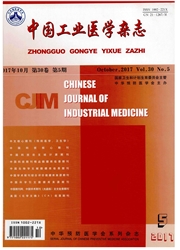

 中文摘要:
中文摘要:
目的了解某露天铁矿厂主要噪声暴露工人的噪声暴露水平。方法测量对象包括此铁矿厂主要噪声暴露工人,使用25台个人声暴露计对每个噪声作业工种进行至少一个班次个体噪声暴露测量;计算每名工人40 h工作时间的等效连续A声级(LAeq.40 h),用SPSS13.0软件计算各工种平均噪声水平,绘制噪声时间曲线。结果整个矿山的噪声作业工人平均接触噪声水平为88.8 dB(A),除选矿作业区为稳态噪声,其余5个作业区为非稳态噪声。选矿作业区球磨工噪声水平最高,为92.8 dB(A),破碎作业区皮带工及检修作业区维修工噪声水平次之。穿爆、采矿及运输作业区3种司机噪声暴露水平最低,未超过国家标准85 dB(A)。与环境噪声测量结果比较,个体噪声暴露测量更准确。结论此铁矿厂选矿、破碎及检修作业区噪声水平超过国家标准,这些工人应重点加强个体噪声防护。
 英文摘要:
英文摘要:
Objective To comprehend the noise exposure level in such an outdoor iron mine factory. Methods The subjects were chosen from the main work-types in the factory; 25 individual noise dosimeters were used to measure the noise exposure levels, at least one work-shift of each work-type in the factory were measured. Then, the equivalent continuous A sound level in 40 hours weekly working time (LAeq 40h ) and mean noise levels were calculated by using software SPSS13.0. Results The results showed that the average noise level in the iron mine factory was 88.8 dB(A), the noise in all the workshops was nonstationary noise except ore dressing operaing area. The highest noise exposure was in the milling workers of ore dressing oncrating area, which reached 92.8 dB ( A ) ; secondary, were the belt-conveyor workers in crushing workshop and the maintain workers in maintaining workshop, which were 89. 2 dB( A)and 88.5 dB(A) respectively. The lowest exposure to noise was in the drivers of blasting, mining and transportation workshops, the mean exposure levels were lower than the national hygienic standard[ 85 dB (A) ]. Generally, comparing with the environmental noise measurement, the induvidual noise measurement seemed more accurate. Conclusions The results suggested that the noise exposure levels of workers in ore dressing, crushing and naintaining workshop exceeded national hygienic standard[ 85 dB(A) ], therefore, the hearing protection measures should be taken in these workers.
 同期刊论文项目
同期刊论文项目
 同项目期刊论文
同项目期刊论文
 期刊信息
期刊信息
